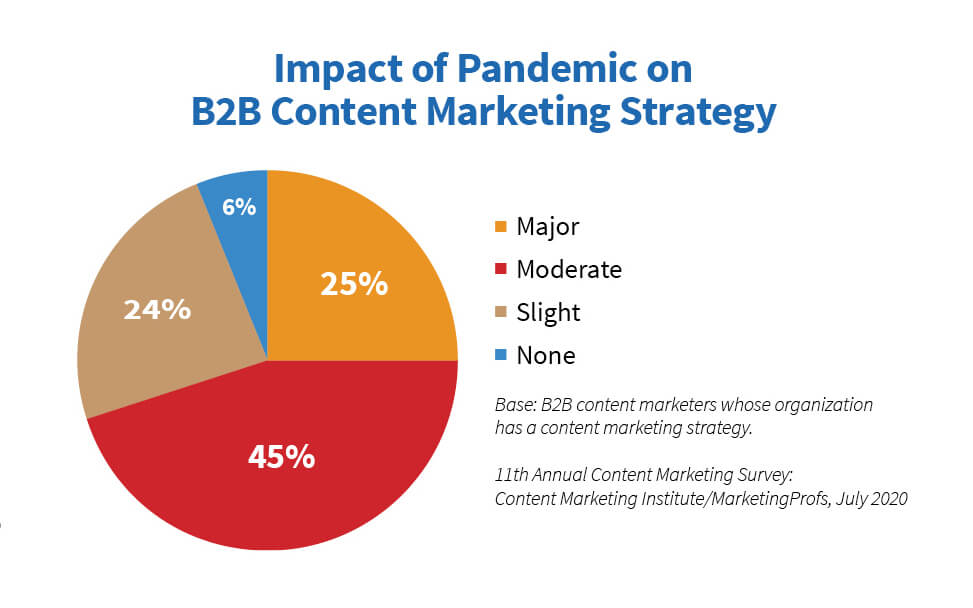Before I jump into unifying your marketing strategies with content marketing, know I think everything should be planned under Search Engine Optimization.
The 2021 research conducted by Content Marketing Institute found that 4 out of 5 content marketers say their pandemic pivots were effective. 70% say that the pandemic had a moderate to a major role in B2B content marketing strategy. Provided is a graph from the Content Marketing Institute study.

A study by Content Marketing Institute found that less than half of B2C Marketers meet daily or weekly to discuss their content marketing programs. More than half do not have a documented strategy.
One of the first steps toward unified marketing is documenting strategy, and unified reporting. The real goal is to get teams working together in real-time on a cohesive strategy and then measure effectiveness. The goals and the content should the common thread across all efforts. Everyone in Search Engine Marketing (SEM) is completing some form of content marketing. 93% of B2B marketers are using content marketing. But the majority did not have a defined documented strategy.
Getting a defined documented content marketing strategy consists of:
- Create a cohesive strategy aligned with Search Engine Optimization (SEO), and Search Engine Marketing (SEM)
- Document your strategy
- Create an outline of a unified media plan
- Build a unified reporting
What Content Marketing Is
Content marketing is about your audience and what they care about. Content marketing is storytelling, not pushing your company.
Content marketing is a long-term strategy. It focuses on giving your target audience high-quality content over a long-term period. The relationship between your company and your customers is relevant and requires writing relevant information on a frequent basis
The Blind Approach to Content Marketing
Many marketers are busy churning out content without knowing how to optimize it for the best results.
The common actions are to write content, publish it to blogs (or others forms of media), loop in SEO, and push out content on social media. Then keep the content calendar full of ideas and checked the traffic, engagement, and conversions.
This is a good starting point.
What if you Leverage Content Marketing?
Bill Gates coined “Content Is King” back in 1996. It has been the battle cry of SEO’s everywhere for decades.
From start to finish the content marketing process is often siloed. Content as a whole builds a relationship with the audience and shapes a company. A few SEO agencies have begun restructuring to give clients a unified approach for all search, paid ads, content, and social media.
Content can be anywhere and part of a company.
A survey from Clutch in 2017 showed the top means of content distribution were paid ads. Just using content for paid ads does not mean companies have a cohesive strategy.
With Pay Per Click Advertising (PPC), a company pays for their ads by impressions or clicks. PPC falls under Search Engine Marketing (SEM), SEM is a paid strategy and SEO is an organic strategy. When done right, PPC helps you earn quality leads. You will find PPC ads are most commonly displayed on search engine results pages (SERPs), they are also used on social channels.
Content marketing can be leveraged in all phases of the customer journey and conversion funnel for your company.
Marketing Funnel and the Self-guided Customer Journey
Today’s users are taking a self-guided journey through the conversion funnel.
Consumers, we want to come and go as we please – dart in and out of any phase. I will often Google a fact or just browse an purchase from an online store. Today’s users find what they want, and look when they want. They can stay as long or leave as quickly as they please.
Good online marketing enables customers to do what they want. As consumers want the marketing funnel.When it’s time to buy or move onto the next phase make it easy and possible. If we can’t move onto the next phase convert, we will be disappointed and we won’t convert. We want to buy, fill out a contact form, call, or sign-up. The familiar conventions of the funnel need to be ready and working. The familiar conventions of the funnel also need to be easy to find and access (calls to action, contact forms, product information, checkout, online chat, and phone numbers)
Content Planning Helps the Funnel
First, align the content to your goals then create a content matrix (or content map). Don’t start just writing content or with a content calendar. Review your target audience and your existing content. Craft customer personas, services, product categories, or business units. Then divide those segments according to the three stages of the customer journey.
Awareness
The content in this phase should educate, and engage your audience. This is the widest net with the most users. This is where brands are built with brand awareness. The content should align with your audience’s interests.
Consideration
This should help your customer identify needs and solutions. This is B2B creates a business case that aligns your solution with your customer’s needs.
Decision
Easy. The content crates validation for the customer to move forward.
Create a unified Content Marketing and Media Strategy
Search Engine Optimization (SEO) is a given. Content Marketing means actually marketing your content. Getting your content in front of your audience is key. SEO is not typically the only means of marketing most companies. Search Engine Marketing (SEM), and Social MEdia are also used. All content marketing should have a media plan that aligns with your goals. Also, your objectives, strategies, tactics need to be listed and measurement.
Unified Marketing Reports
Content marketing takes organization, collaboration, and optimization. There are tools for content marketing that help you research and track results. Here are a few of my favorite content marketing tools.
- Moz Keyword Explorer has guides and workflows using features like relevancy and opportunity scores
- Answer the Public is a topic exploration tool similar to Ubersuggest, but with an easier interface
- Buzzsumo helps you find content that performs best
- Buzzstream is a research and outreach tool that lest you keep track of what works and what doesn’t
Documenting your strategy and collaboration tools shows you exactly where marketing teams must unify. With modern tools, there is no excuse not to plan, document, and measure content marketing. Here is an example of measurable unified reporting.


